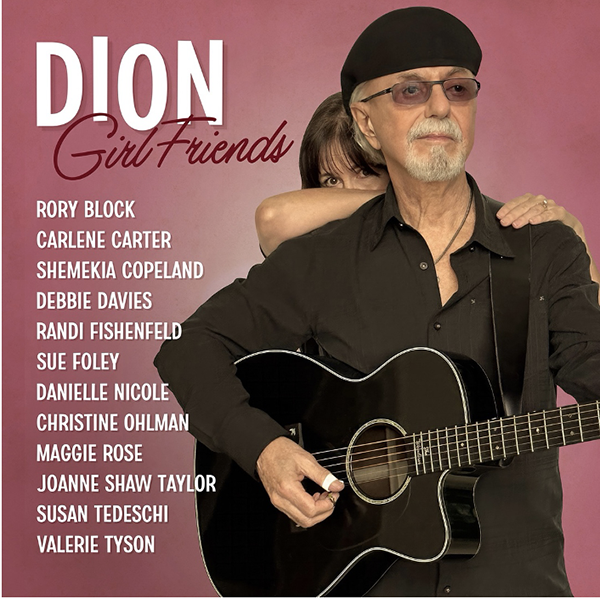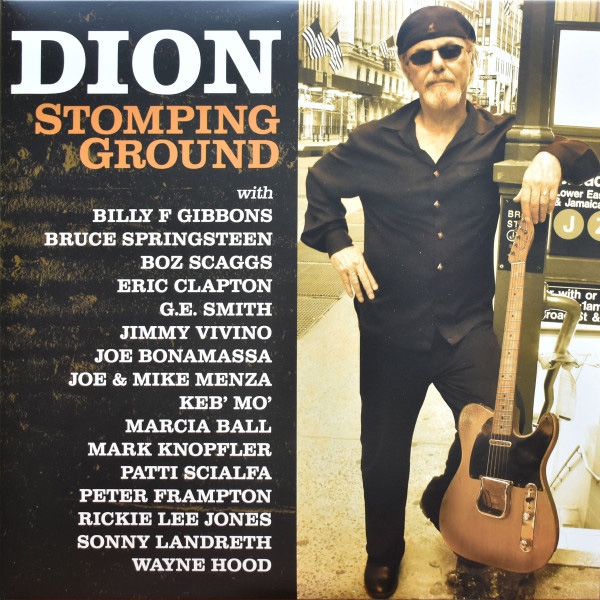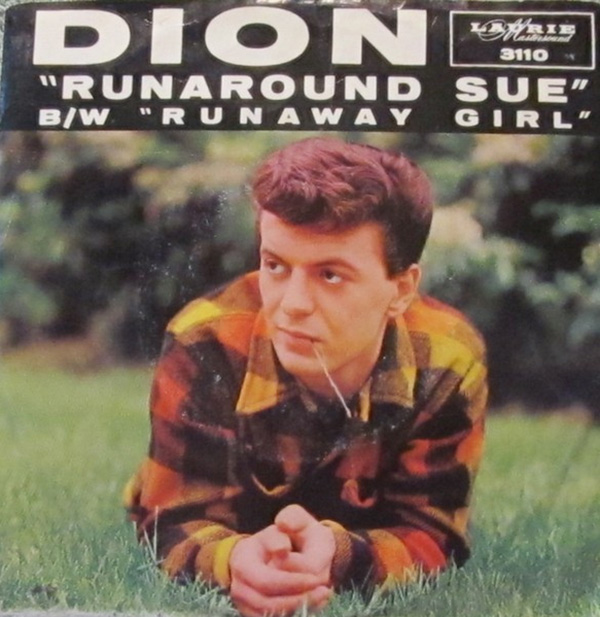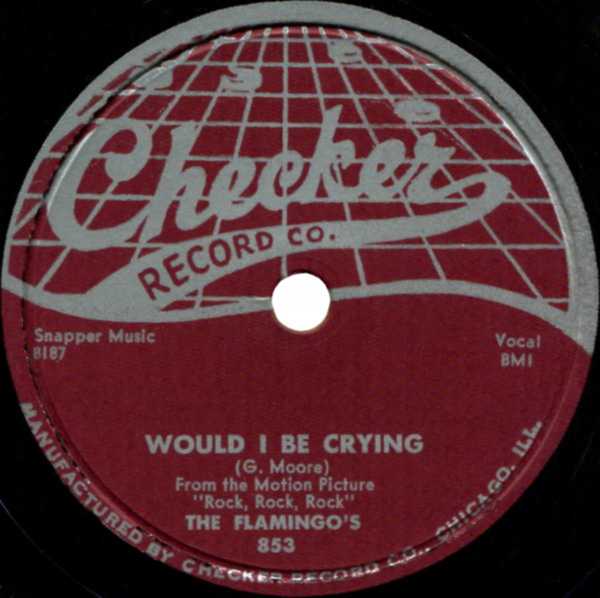Dion, the Eternal Wanderer and Once and Future King of the New York Streets, Discusses How His Unwavering Soul Force Is Geared Toward Being Heard on Double 180g Vinyl

If there’s a musician who’s taking better advantage of that figurative Dorian Gray picture on their wall than singer/songwriter/guitarist Dion DiMucci, I haven’t met them. The eternal Bronx-born Wanderer is still going strong at age 84, having issued three all-new 180g 2LP sets in the past four years. The most recent of which is Girl Friends, a four-sided, 12-track affair that celebrates Dion’s collaborative spirit and spark with a plethora of female artists, and it was just released by Keeping The Blues Alive this past Friday, March 8, 2024.
“What happened was, I did a couple of songs with female artists on Blues With Friends and Stomping Ground,” Dion clarifies, in relation to his previous pair of 180g 2LP sets that were released in June 2020 and November 2021, respectively. “I had such a good time working with Marcia Ball and Rickie Lee Jones [on Stomping Ground], and also Samantha Fish [on Blues With Friends], that I guess the idea kind of marinated in my head. I thought, ‘Hey, it would be great to do a whole album with all these women.’ I’ve always loved listening to Susan Tedeschi and Sue Foley, so I started writing songs with stories to them and personalized them, because I didn’t want to make the album boring.” No worries, there, Dion — your track with Tedeschi, “Soul Force,” is a rip-roaring Girl Friends A1 album opener, while your vocal blending with Foley on “Hey Suzy” (Side D, Track 1), not to mention the heartfelt duet with Carlene Carter on “An American Hero” (Side B, Track 2) each hit home in all the right places (for starters).
The stats for the 180g 2LP edition of Girl Friends are these. The album was co-produced by Dion and his longtime creative collaborator, multi-instrumentalist Wayne Hood, who also handled the arrangements, mixing, editing, and mastering duties. The lacquers were cut by Kevin Park of Lacquer Channel Mastering in Toronto, and the vinyl was pressed by Microforum Vinyl Record Pressing in Toronto. Though 24-bit/96kHz digital files were used in the process, I can personally affirm the warm, analog feel of all 12 tracks on Girl Friends, each of which have the right amount of space to breathe across four sides (three tracks per) rather than being crammed onto two. (My ratings — Music: 8; Sound: 8.)

In fact, Hood/Dion production team also followed this practice with Dion’s previous two LPs on the Keeping The Blues Alive label — the aforementioned June 2020 180g 2LP set Blues With Friends (shown above; standout tracks include “Can’t Start Over Again” with Jeff Beck [Side A, Track 4] and “I Got the Cure” with Sonny Landreth [Side C, Track 2]), and the November 2021 180g 2LP offering Stomping Ground (its standouts being “Dancing Girl” with Mark Knopfler [Side A, Track 3] and “Angel in the Alleyways” with Patti Scialfa & Bruce Springsteen [Side C, Track 3]).
Dion feels quite rejuvenated by this recent burst of activity. “I love creating. It’s one of my favorite things,” he says, most intently. “There’s nothing better than creating something, and then you have it. You hear it, and it’s physical. I just love that. I think in the last four years, I wrote 30 of the best songs I’ve ever written. I couldn’t have planned it if I tried.”
And he’s not done yet, either. “I feel so blessed that I started out like I did, and that I’m still doing it and loving it,” Dion continues. “I really am a grateful person, that I get to do this — that I get to sing these songs for people. I’ve made a lot of friends with the music, and I hope the music makes a lot of friends — a lot more friends.” Dion, I think it’s fair to say that, with songs like these, finding new friends is something you’ll never have to worry about.
In a recent Zoom interview, the ageless Dion, 84, and I discussed why he sequences his LPs like a live show, how “The Wanderer” is one of his definitive “bragging rights” songs, and why he’s considering resurrecting some of his personal favorite songs from years past on vinyl. People called me the scandalizer / The world was my appetizer. . .

Mike Mettler: I’m very glad you decided to embrace doing double vinyl for your last three albums. As an artist who grew up in that prime vinyl-oriented era, how important is it for you to have people listen to your music on vinyl today?
Dion: Well, I’ve always liked the idea of holding it in your hand — you know, just the physical feel of it — seeing all the pictures, and getting the words to the songs and some information on the people who are on the album, and seeing their pictures too. Just the whole trip of, the more you love something, the more you want to know about it — and that’s the way I am. I pick up an Allman Brothers album, and I want to know who’s playing on it.
Mettler: Me too. I’ve always likened the experience of sifting through liner notes and album credits to how we used to look at the box scores in the paper to see who did what in yesterday’s games. How do you guys handle the test pressings for these newer albums of yours?
Dion: Wayne Hood, my co-producer, does it. He has two record players, and I go down there where we’ll check it out and decide, “Yeah, this is good. This sounds good.”
Mettler: Do you give Wayne any technical notes at that point of playback? Do you go back and forth about what should be where in the mix?
Dion: We do that first, before we put it onto the lacquer. And then, the people who run the lacquer, who print it, they’re pretty hip with it. They [i.e., Microforum, in Toronto] have the right equipment to see if something is knocking the needle off the table. They’re pretty good with that.
Yeah, it’s interesting how they do that now. I don’t like mastering, or squashing the sound, or compressing it. I try to get as much as I can on there, you know?
Mettler: Yeah, and I think spreading things across four sides instead of two helps with that too. Since you’ve done it that way for your last three albums, sequencing is clearly still important to you.
Dion: Well, yeah, and I look at it almost like a show. I like to start it out with something with a little energy, and then it’ll be something like, “Okay, now you’ve heard the way we sound. How about this?” — and then you throw them something you really like. And then the third song is kind of like you’re looking through the audience, just saying hello personally. For the fourth song, maybe you do a ballad, or you slow it down a little. So, it’s stuff like that. I just like to put albums together like a show.

Mettler: That’s a great way of putting it, especially with the last one from 2021, Stomping Ground. What’s the secret of having a voice sound this good when you’re in your 80s? I mean, you sound as good to me today as you did in the 1950s and ’60s. What is the secret of that?
Dion: Well, hmm. That’s interesting. I can say I have been clean and sober for 55 years. I was essentially [imbibing] from 14 to 28, and I would’ve been dead if I kept that up. But I made a decision back there. I just cried out to God, “Help me,” and I’ve been clean and sober ever since. I’ve been in 12-step, spiritual recovery-based programs for 55 years — but the other thing is, I’m married 60 years to my childhood sweetheart, and it keeps me grounded. I have three beautiful daughters and four beautiful granddaughters, and two sisters. I’m always around women, and to me, they just grace the room.
Mettler: That’s such a beautiful thing to hear. There’s also a tone in your “current Dion voice,” as I’m calling it — one that reminds me of some of the more classic blues singers we all know so well. Is that partially due to how you’re writing and singing a song like “Soul Force” on Girl Friends (Side A, Track 1)? I mean, is that a conscious thought for you as to how you’re doing it?
Dion: Well, you pick up — you do something a little different in the blues than I was doing in rock & roll. Instead of (sings phrase with all the same note structure), “Everybody tell me,” it’s (voice goes up with each syllable) “Tell me-ee-ee” — you know, like you do scales sometimes. It’s fun to do that because of the way the notes lay themselves down in the genre.
Dion: But what I wanted to bring to it, Mike, is like — the blues genre is very guitar-driven, which I love. I mean, that’s why I’m in it. It’s so expressive. It’s like the only rock & roll that’s real these days.
And I wanted to write some songs that just changed it up a bit, like (cites “Soul Force” lyrics), “I thought that I could dazzle by distraction / And how could she resist my kind of action,” you know? I just wanted to bring something a little different to the songwriting, so I’ve been concentrating on that. I start out with a theme — and sometimes you can peter out at the end of the song, but I wanted to stay true to it right to the end, and make it as cool at the end as it is in the beginning. I think I’ve accomplished that, in writing these songs.

Mettler: I would tend to agree with you there. I want to jump a little ways back with you now, because when I was listening to “The Wanderer” [Dion’s iconic 1961 single on Laurie Records, which reached No. 2], it struck me how there’s an interesting, almost guttural tone to your voice. Did you want to take a lower tone there to better represent that character in the song?
Dion: Yeah. It’s funny, Mike — a lot of people think every song you write is autobiographical. They think you’re singing about yourself. In a lot of cases, yeah, there’s a part of you in the song, and some are very autobiographical — but sometimes, you’re almost like an actor.
The Wanderer is a funny guy because he’s carefree — he’s a player. He’s just doing pretty good with the ladies (both chuckle) — but then he has a moment of clarity. He goes, “I roam from town to town / I go through life without a care / And I’m as happy as a clown / I with my two fists of iron but I’m going nowhere.” And then he gets back into his deal, you know? (laughs heartily)
Mettler: Right — we hear this brief moment of clarity before he goes back to the full swagger.

Dion: Yeah, yeah, and then there’s “Runaround Sue” [Dion’s No. 1 1961 single, also on Laurie]. This is funny. “Runaround Sue” was written about a girl in my neighborhood. She was pretty loose. I didn’t know her too well, and she went out with the older guys. But somewhere down the line, we [Dion and Ernie Maresca] just wrote a song, and it didn’t fit with her actual name — it didn’t land — so we put “Sue” there instead, and that fit. That’s a good rocker name, right there.
One time, I was at a radio station with a disc jockey. He called himself “Keeper of the Keys.” I was answering questions and people were calling in, and this girl that I wrote “Runaround Sue” about called. She was now married to a rabbi, she had six kids, and was perfectly happy. I must have blushed in the studio!
Mettler: Then I guess her name now would have to be something like “Settledown Sue” at this point, right? (laughter) Since we’re talking about classic singles from back in the ’50s and ’60s, I’m sure you were buying 45s and 78s as a kid. Is there one record you started with where you felt like, “Yeah. this is the one that’s my thing,” one that you really took to heart? Anything like that?

Dion: Yeah. Early on, I heard Lloyd Price, and I heard Little Richard, Jerry Lee Lewis, Chuck Berry — wow. Very early on, I bought a Flamingos record because I was in love with this girl, Susan, who I’m still married to today. I was like, 16, and I went up to the record shop and I got “Would I Be Crying.” It was a backside of some record they made — and I loved it. I got it and, I don’t know, it just had a romantic sound to it. I didn’t even know what it said, but, yeah, I had 45s and 78s, sure. [“Would I Be Crying” is the B-side to The Flamingos’ 1956 single “Just for a Kick,” on Checker. It was originally available as a 10-inch shellac 78, and then as a 45 a year later in 1957.]
Mettler: Where was the record shop you bought all those 45s and 78s located?
Dion: Well, I was in the Fordham section in The Bronx, New York City. It was a main street that ran through it called Fordham Road. Fordham College is right on Fordham Road. It runs up to the Grand Concourse, which is like the Champs-Élysées of The Bronx. (Dion smiles; MM laughs) And Yankee Stadium is right off of the Grand Concourse.
Lou Cicchetti’s record shop was right on Fordham Road. It was called Cousins, and I went up there when I was 12 years old because I had heard Hank Williams. I was really an odd bird in New York — in The Bronx — and I was into Hank Williams. I asked Lou Cicchetti who he was, and he had a couple of records of his there.
I went in the booth and put on the 78 with the needle. I had 78s, and my girl, Susan, had a 45 player. I was odd. (chuckles) Anyway, I bought those two records, and then Lou would call my house every time a new Hank Williams record would come in. When I went on tour with Buddy Holly in [October] ’58, actually, man, I knew about 40 Hank Williams songs, and I’d sing the backsides of hit records — everything.
Mettler: Man, that’s amazing. Do you still have any of those records?
Dion: Oh, no. No. That takes up a lot of room! (smiles)

Mettler: Tell me about it! (both laugh) Now, there was another vocal thing I want to ask you about — it’s in some of the choruses and at the end of “King of the New York Streets” on your 1989 album on Arista, Yo Frankie (Side 1, Track 1), where you go into those little scat modes. Was that an in-the-moment thing that felt right when you were doing it, or did you plan that ahead of time?
Dion: You know, I think I was probably filling it in for the guitar player! Dave Edmunds, he was producing it. “King of the New York Streets” and “The Wanderer,” I always put them in the category of the blues genre — the thing I call bragging rights. Like, “I turned gangs into fertilizer” [a line from “King”], and “I got the cure” [from the song of the same name on Blues With Friends]. That theme always emerges in my head — so, on this new Girl Friends album, I wrote a song called “Don’t You Want a Man Like Me” (Side B, Track 3), and I did it with Rory Block. At the end of that song. I’m telling you, her husband came over to me and he says, “I wouldn’t play that for your wife!” (both laugh)
Mettler: There is a level of swagger in a lot of blues songs, that’s for sure. You go back to certain Muddy Waters and Willie Dixon records, and it’s like, “I’m the man here, so get out of my way. Or do get in my way, and we’ll see what happens.”
Dion: Absolutely. Yeah, that’s it.
Mettler: I’d love to see you get the rights to reissue Yo Frankie on vinyl yourself some day, since I bet a lot of people don’t know that album at all. And I’d love to hear your [February] 2016 album that’s only on CD [on the Instant label], New York Is My Home, get onto vinyl too. Can you make all that happen, please? (laughs)
Dion: Well, that’s interesting. I do own the rights to all the blues stuff I’ve been doing over the last two decades. And maybe I should resurrect a lot of my favorite songs through the decades on vinyl because, hey, I feel like, at this point, I probably am the only artist from the ’50s who has stayed creative and relevant. You’re making me think about it, so, yeah — thank you.
I tell you, Mike, it’s been so enjoyable. In the early days — and even with Yo Frankie, which was done in ’89 — it was like agony, waiting for people to get ready to record because you’re on everybody else’s schedule. Now I’m in control, and it’s so enjoyable. It’s not like agony. I feel like I’m skating, or like I caught the wave.

Mettler: That’s great to hear, seeing how you’re in such a creative phase right now. So, let me do this to wrap things up for us. I like to ask this question of a lot of people, and since we’ve been talking about the past and the present, let’s now jump 50 years into the future, to where it’s 2074. Unless there’s some weird science going on, you and I are probably not physically on the planet anymore. Well, maybe you will be (laughs), but let’s just say, however people listen to music in 2074 and they type “Dion” into that listening device of theirs, what do you want them to get out of that experience?
Dion: Wow. Well, I’ve always been the same. I’m easy to understand — I think. When I first heard Jimmy Reed, and I first heard Hank Williams when I was 11 and 12 years old, something went into me, and it brought me to a place of transcendence and to a place of enchantment, delight, and pleasure that I didn’t experience before.
All my life, including right this minute, I’ve been trying to — well, not even trying to, but my passion is to put a song together to transmit that feeling to other people, and hopefully keep them on a trip to bring them to a place of enchantment. And that’s something you don’t expect every day, because you got to pay the bills and deal with all the bulls--t that’s going on. But they hear a song of mine, and they feel it’s transmitted to them. Something happens with it where they’re feeling something transcendent.

DION
GIRL FRIENDS
180g 2LP (Keeping The Blues Alive)
Side A
1. Soul Force (With Susan Tedeschi)
2. I Aim To Please (With Danielle Nicole)
3. Stop Drop And Roll (With Valerie Tyson)
Side B
1. Do Ladies Get The Blues (With Christine Ohlman and Debbie Davies)
2. An American Hero (With Carlene Carter)
3. Don’t You Want A Man Like Me (With Rory Block)
Side C
1. Sugar Daddy (With Christine Ohlman)
2. Endless Highway (With Randi Fishenfeld)
3. I Got Wise (With Maggie Rose)
Side D
1. Hey Suzy (With Sue Foley)
2. Mama Said (With Shemekia Copeland)
3. Just Like That (With Joanne Shaw Taylor)






















































